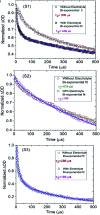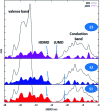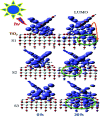On how ancillary ligand substitution affects the charge carrier dynamics in dye-sensitized solar cells
- PMID: 35540976
- PMCID: PMC9080644
- DOI: 10.1039/c8ra02968g
On how ancillary ligand substitution affects the charge carrier dynamics in dye-sensitized solar cells
Abstract
With respect to N3, a champion sensitizer in dye-sensitized solar cells (DSSCs), S3 which contained a phenTz (1,10-phenanthroline 5-tetrazole) ancillary ligand showed outstanding improvements in molar extinction coefficient (ε) from 10 681.8 to 12 954.5 M cm-1 as well as 0.92% and 0.9% increases in power conversion efficiency (PCE) and incident photon-to-electron conversion efficiency (IPCE), reaching 8.46% and 76.5%, respectively. To find the origin of the high performance of the DSSC based on a phenTz ancillary ligand, transient absorption spectroscopy (TA) was carried out and indicated that the rate of the regeneration reaction is about 100 times faster than the rate of recombination with the dye which is very exciting and surely a good reason to promote the phenTz ligand as a promising ancillary ligand in DSSCs.
This journal is © The Royal Society of Chemistry.
Conflict of interest statement
There are no conflicts to declare.
Figures






Similar articles
-
Superior Light-Harvesting Heteroleptic Ruthenium(II) Complexes with Electron-Donating Antennas for High Performance Dye-Sensitized Solar Cells.ACS Appl Mater Interfaces. 2016 Aug 3;8(30):19410-7. doi: 10.1021/acsami.6b04411. Epub 2016 Jul 22. ACS Appl Mater Interfaces. 2016. PMID: 27409513
-
Ultrafast interfacial charge transfer from the LUMO+1 in ruthenium(ii) polypyridyl quinoxaline-sensitized solar cells.Dalton Trans. 2018 Jan 2;47(2):561-576. doi: 10.1039/c7dt03769d. Dalton Trans. 2018. PMID: 29239438
-
Novel Ruthenium Sensitizers with a Phenothiazine Conjugated Bipyridyl Ligand for High-Efficiency Dye-Sensitized Solar Cells.ACS Appl Mater Interfaces. 2015 Dec 23;7(50):27831-7. doi: 10.1021/acsami.5b09160. Epub 2015 Dec 14. ACS Appl Mater Interfaces. 2015. PMID: 26624527
-
Effect of the Ancillary Ligand on the Performance of Heteroleptic Cu(I) Diimine Complexes as Dyes in Dye-Sensitized Solar Cells.ACS Appl Energy Mater. 2022 Feb 28;5(2):1460-1470. doi: 10.1021/acsaem.1c02778. Epub 2022 Jan 13. ACS Appl Energy Mater. 2022. PMID: 35252772 Free PMC article.
-
Review on fabrication methodologies and its impacts on performance of dye-sensitized solar cells.Environ Sci Pollut Res Int. 2022 Mar;29(11):15233-15251. doi: 10.1007/s11356-021-18049-2. Epub 2022 Jan 3. Environ Sci Pollut Res Int. 2022. PMID: 34978676 Review.
Cited by
-
Ruthenium (II) Complexes Based on Phenanthroline-Tetrazole as Possible Anticancer Agents.Iran J Pharm Res. 2023 Sep 7;22(1):e136738. doi: 10.5812/ijpr-136738. eCollection 2023 Jan-Dec. Iran J Pharm Res. 2023. PMID: 38116569 Free PMC article.
References
-
- Green M. A. Hishikawa Y. Warta W. et al. . Prog. Photovoltaics. 2017;25:668.
-
- National Renewable Energy Laboratory Efficiency Chart http://www.nrel.gov/ncpv/images/efficiencychart.jpg, accessed January 2017
-
- Tiep H. Ku Z. Fan H. J. Adv. Energy Mater. 2016;6:1501420. doi: 10.1002/aenm.201501420. - DOI
LinkOut - more resources
Full Text Sources

